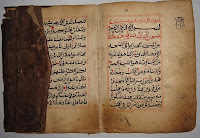In this lot, there are 5 different Etiopia manuscripts of the same Quran Juz i.e the Juz 14. It is interesting to see by comparison how this manuscript codicology differs. In general these manuscripts are binded by leather probably goat's and the finishing was executed in a rough manner. Some of these covers were plainly embossed and with flaps.
The writing material used for all of these manuscripts are paper of western type. Unlike Ottoman Quran, there is no system of prescribing quantity of written lines per page and quantity of folios. In a typical Ottoman Quran, we could always find written lines of 15 per page and a total of 10 folios per juz. Whereas in these Etiopian manuscripts, some manuscripts were written in 9 lines per page and others 11 lines per page, 19 folios & 25 folios respectively.
There is no illumination or motive throughout this manuscript except on the first juz ( which I will post on next entry, Insyallah). Calligraphy written in black with some in red especially on the diacritical note and heading.
For time being I will categorize the calligraphy executed in this manuscripts as Sudani however I still need to do more research
about this type of calligraphy. It looks like in between Sudani & Somali
calligraphy but definitely stemmed from a Maghribi style. No
pages are missing.
These manuscripts are believed to have been written from 18-19th century. So far I havent found any date on these manuscripts except some ownership notes from the owner detailing the purpose of the writing of this manuscript especially for waqf. I am still waiting subsequent shipment of similar manuscripts from Etiopia and I hope at least one of the manuscripts is dated.
This is a very rare acquisition because we dont see many Etiopian Quran
in the market or in international hands. I am blessed to have acquired this
manuscript from a
friend in Etiopia recently.
Check below links to compare with Somali & Sudani Quran :
Item : Antique Etiopia Quran
Manuscript Content : Juz 14 of Quran
Dim : 18 cm x 13 cm x 2 cm
Date : 18-19th century
Copyist : anonymous
Origin : Etiopia
Calligraphy : Sudani??
Design : Written in Sudani scripts in black
Purchased Price :US
Manuscript Content : Juz 14 of Quran
Dim : 18 cm x 13 cm x 2 cm
Date : 18-19th century
Copyist : anonymous
Origin : Etiopia
Calligraphy : Sudani??
Design : Written in Sudani scripts in black
Purchased Price :US


























.JPG)






















.JPG)